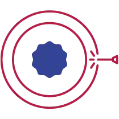
Laser-assisted hatching (LAH) is a medical procedure used in assisted reproductive technology (ART) to enhance the chances of successful implantation during in vitro fertilization (IVF). It involves the use of a focused laser beam to create a small hole or thinning in the outer shell of an embryo called the zona pellucida.
The zona pellucida is a protective layer surrounding the embryo that needs to be breached for successful implantation into the uterine lining. By performing laser-assisted hatching, the embryologist aims to facilitate the embryo’s hatching process, allowing it to break out of its shell and implant more easily.
The procedure typically takes place shortly before embryo transfer, under microscopic guidance. A laser beam is directed at the zona pellucida, and a small opening is created without damaging the embryo. This technique is considered more precise and controlled compared to other mechanical or chemical methods of hatching.
Laser-assisted hatching is often recommended in specific cases, such as when the embryo has a thick or hardened zona pellucida, or in cases where previous IVF cycles have resulted in failed implantation. By facilitating the hatching process, LAH aims to increase the chances of successful implantation and subsequent pregnancy.
It’s important to note that the specific protocols and techniques used in laser-assisted hatching may vary among fertility clinics, and its implementation is based on individual patient characteristics and medical recommendations.
